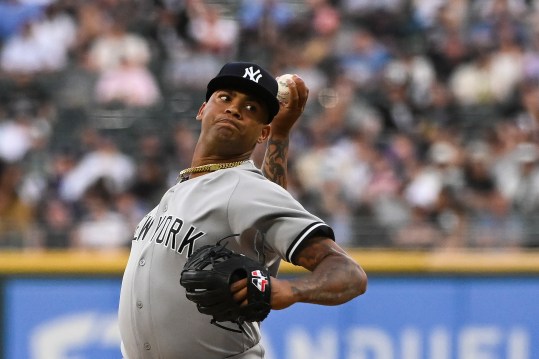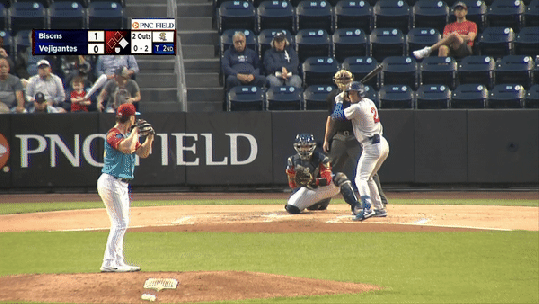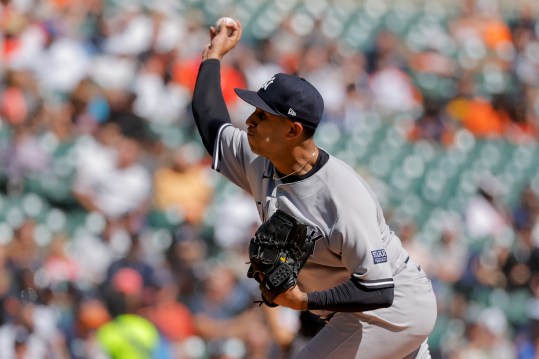
As the Yankees look to replenish their pitching staff following the trades for Juan Soto, Trent Grisham, and Alex Verdugo, the team could get innovative next season. Even if they had landed the services of Yoshinobu Yamamoto, the team would likely need to use more than just five starters next season, especially given the way pitching injuries are headed. With a report from Ken Rosenthal about a potential ‘super bullpen’ for 2024, the Yankees could potentially build a bullpen fit to slot into the rotation whenever they need a sixth starter or in the case of injuries.
Some of the younger pitching talent the Yankees have could allow the team to roster arms who can give them multiple innings in any situation, and they could get innovative with one of their final rotation spots next season.
Versatile Young Arms in the Yankees’ Farm System

Despite what the Yankees lost in the trade market, they still have depth in the upper levels of their farm system that can help their pitching staff in 2024. There’s a quartet of arms in their organization who could fill out spots in the backend of their bullpen or make spot starts as well. The one with the most MLB experience is Luis Gil, who has a sub-4 ERA in his seven big league starts with a 29.1% strikeout rate, and while the stuff is excellent, the command has never been consistent enough.
In his Minor League career, he’s sported a 13.7% walk rate, and while he has a 3.52 ERA and 3.67 FIP between all levels of MiLB, it’s hard to imagine that he could hold himself up as a starting pitcher in the big leagues. Coming off of Tommy John Surgery won’t help either, as command typically takes more time to return following an injury than velocity. If the Yankees could limit to the first time through the order, that could allow him to be more effective in shorter bursts while keeping his innings down as he works back from an injury that sidelined him for over a year.
Having a pitcher with excellent stuff like Luis Gil to offer two or three innings every three days would certainly bolster the Yankees’ pitching staff, and as he gets more comfortable, he could be asked to make spot starts for the team. Another pitcher in a situation like Gil’s would be Yoendrys Gomez, who similarly has a great arsenal but lacks the command to remain a full-time starter. In Somerset, the 24-year-old right-hander had a 3.58 ERA in 19 starts, but he rarely exceeded the third inning as he worked back from rehab.
- Yankees are still paying outfielder they cut two years ago almost $10 million in 2025
- Yankees bring back injury-prone bullpen arm on $1.8 million deal
- Yankees’ young first baseman might be primed for huge 2025 season
Gomez sports a deep pitch mix with a four-seam fastball that he throws from a lower slot with plenty of carry, and he also has a slider, cutter, and curveball in terms of his breaking pitches. His changeup also gives him a pitch to help him handle left-handed batters, and I believe that he could be one of the better young arms on the team in 2024. He made his MLB debut this past season, recording four strikeouts in his two clean innings of work against the Toronto Blue Jays, displaying his excellent stuff and looking sharp out of the bullpen.
His teammate at Double-A, Clayton Beeter, is another pitcher on the Yankees’ 40-man roster who could greatly bolster their pitching depth, as he was able to make it to Scranton this past season with the Yankees’ Triple-A affiliate. Added to their 40-man roster this past winter, Beeter had a 3.62 ERA across 26 starts this past season, striking out 165 but walking 75 batters as well across 131.2 innings between AA and AAA. His 4.94 ERA in Triple-A seems underwhelming, but it was better than the International League average due to the insane run environment at that level.
The 25-year-old right-hander relies on a four-seam fastball and slider heavily, mixing in some curveballs and changeups from time to time as well to catch left-handed hitters off guard. Until he fully develops a third pitch to handle left-handed hitters, he’ll likely struggle to stick as a starter in the Majors, but he has the makings of a multi-inning relief weapon. This past season was his first full year as a starting pitcher, and he’ll have some tweaks he can make in the winter to maintain his velocity throughout the entire season.

These trio of arms share one thing in common, and that’s the doubt in their abilities to be full-time MLB starters, but that doesn’t mean they can’t help a pitching staff. Between the three of them, they could likely give the Yankees two strong innings apiece in any game, and that’s two-thirds of your ballgame that could be solved by just deploying these three low-cost arms. If they get six innings out of Clarke Schmidt in a night, they could hand the ball to Beeter to close things out, saving their bullpen not just for the next day but also limiting their workload before they head into October.
As for the final pitcher in this group of four, those doubts about being a Major League starter aren’t as prevalent, as Will Warren has proven to be an effective starter at every level he’s pitched at in his young career. The 24-year-old right-hander displayed excellent stuff between Double-A and Triple-A this past season, with a 3.35 ERA and 149 strikeouts in 129 innings this season. Issues against left-handed hitters improved throughout the season, with September being his best in the organization.
Through his final five outings, he allowed just a .300 OPS against left-handed batters as he put up just a 0.63 ERA, not allowing a single home run over that stretch and striking out over 30% of batters faced. His 124 Stuff+ was the best in all of Triple-A (min. 1,000 pitches thrown), and the team is expected to utilize him in a fifth starter or long relief role. I believe Will Warren has the makeup of a promising starter at the Major League level, and his deep pitch mix with excellent pitch shapes is certainly enticing.
Baseball America and FanGraphs both have them in their top 10 lists for the Yankees’ farm system and while he’s currently not on the 40-man roster, he’ll likely be added soon. Warren boasts arguably the highest ceiling and upside in this group of young arms, and the Yankees could turn to all four of them throughout the grind of a 162-game schedule. It could be through winning spots in Spring Training, filling in for injured players, or even potentially taking spots from other players on the roster mid-season, but I expect all four of these names to make an impact in 2024.
Using them in long-relief or spot-starter roles allows the team to limit how many times they’re pitching past the fifth inning, which could increase their effectiveness as they’re pitching in shorter bursts. While it’s not pretty, bullpen games were utilized heavily this October to great success when planned out properly, and the Yankees certainly have the depth and personnel to do such a thing. Clayton Beeter and Will Warren would provide completely different looks to a lineup, with Beeter throwing from a more over-the-top slot and Warren having more side-to-side movement.
Mixing up looks and arms as they try to develop this crop of pitching talent could help them mightily, and their strategy in free agency, alongside comments from Matt Blake, could provide more insight as to what that could look like.
The Benefits and Structure of a ‘Super Bullpen’

One of the biggest questions lies in how effective bullpen games are, with justified skepticism surrounding whether relying on four or five pitchers in a single day can prove effective for any pitching staff. The Yankees played their hand a bit in how they would go about doing a bullpen game, with the team utilizing Luke Weaver as more of an opener than a traditional starter down the stretch. In his first outing with the team, he’d complete four innings against the Pittsburgh Pirates, allowing three runs with seven strikeouts, and the team would follow with Brito (3 IP), Hamtilon (1 IP), and then Holmes (1 IP) to close things out.
In an outing where Weaver went 5.1 innings against the Diamondbacks, the Yankees turned to Jhony Brito for the final 3.2 innings, and in his final start of the season, the veteran would complete four innings in a game where the team would allow a total of six runs to the Toronto Blue Jays. The combined team ERA for those three outings was a 3.46 ERA, and that was while using Luke Weaver and Jhony Brito primarily, a combination that proved effective enough to stabilize the fifth starter spot down the stretch.
Luke Weaver (4.73) projects similarly to Clayton Beeter (4.70) in terms of ERA for 2024, and Will Warren (4.29) projects similarly to Jhony Brito (4.23), according to Steamer, as the pair could make an excellent one-two punch in these bullpen-centric games. Matt Blake spoke with Joel Sherman this past November and mentioned that he expects there to be more versatility in terms of pitching roles, with examples like what Jhony Brito and Randy Vasquez were for the team this past season being used as a comparison.
“You can create more value by having more guys that can give you ‘length.’ It doesn’t necessarily need to be labeled starter or reliever, but stretching guys out and having hybrid roles will probably be a trend”
– Matt Blake
The Yankees certainly have the personnel to pull this off, and if these hybrid roles can continue to work for the Yankees as they did down the stretch, the team could find itself a cost-controlled back-of-the-rotation option. As bleak as this sounds, the number of pitchers who should pitch past the fifth inning hasn’t dwindled compared to years past, it’s just more apparent that we’ve let too many guys do it for too long. Stuff plays better in shorter spurts, and not many arms in the league can remain effective deep into starts.
Rather than leaning on an innings-eater, a team like the Yankees, who are rich with MiLB pitching depth that they can promote and send down whenever, have an advantage as to their roster flexibility. It’s a roster and organization built to take advantage of the bullpen game, and their targets in free agency could certainly aid them in their conquest to build a ‘super bullpen.’

Keynan Middleton was excellent with the Yankees this past season, as while the team’s trade for him was under the radar, the right-hander had a 1.88 ERA and 3.26 FIP across 14.1 innings with the team. They increased his slider usage, and he was more effective with the pitch after being traded, and his ability to pitch two innings in an outing at a low cost could help the Yankees’ bullpen depth tremendously. As mentioned earlier, if the Yankees could roll Will Warren out for four innings and Clayton Beeter for three, Middleton could hypothetically close things out.
That trio of arms would project for a 4.36 ERA in a start, according to Steamer, which is exactly the league-average mark Steamer projects for 2024. A duo I believe could work even better would be Will Warren and Luis Gil, who both possess dominant stuff and provide different looks as well for opposing batters. Replacing Beeter with the hard-throwing right-hander would give the Yankees a projected 4.13 ERA from that gameplan representing one starter, and that would be the Yankees’ third-best SP ERA, according to Steamer.
While there’s more volatility, that’s still a realistic outcome that could give the Yankees better run prevention than they could likely find on the open market. Perhaps Clarke Schmidt can minimize his workload to just four innings, as through the first four innings the former first-round pick had a 4.19 ERA through the first four innings of his starts, and that would likely improve if told to air it out over four innings instead of trying to get through five or six. It goes against conventional thinking, but the Yankees could get more from their current staff with this kind of strategy.
It’s asking a team to mess with a formula baseball has utilized for over a century, but if the Yankees can be innovators on this side of the ball, they could win even more games in 2024 and pair an offense led by Aaron Judge and Juan Soto with a pitching staff that could be near or at the top of the sport in run prevention.